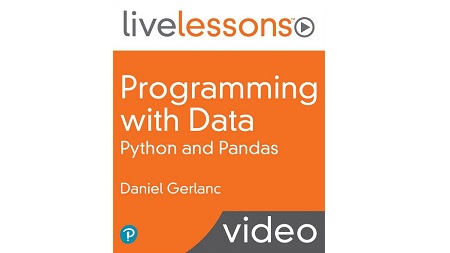
English | MP4 | AVC 1280×720 | AAC 44KHz 2ch | 4h 02m | 4.31 GB
Learn how to use Pandas and Python to load and transform tabular data and perform your own analyses.
In Programming with Data: Python and Pandas LiveLessons, data scientist Daniel Gerlanc prepares learners who have no experience working with tabular data to perform their own analyses. The video course focuses on both the distinguishing features of Pandas and the commonalities Pandas shares with other data analysis environments.
In this LiveLesson, Dan starts by introducing univariate and multivariate data structures in Pandas and describes how to understand them both in the context of the Pandas framework and in relation to other libraries and environments for tabular data like R and relational databases. Next, Dan covers reading and writing to external file formats, split-apply-combine computations, introductory and advanced time series, and merging and reshaping datasets. After watching this video, Python programmers will gain a deep understanding of the Pandas framework through exposures to all of its APIs and feature sets.
Learn How To
- Avoid common pitfalls and “gotchas” in Pandas by understanding the conceptual underpinnings common to most data manipulation libraries and environments
- Create univariate (Series) and multivariate (DataFrame) data structures in Pandas
- Read from and write to external data sources like text and binary files and databases
- Use the Split-Apply-Combine technique to calculate grouped summary statistics like mean, median, and standard deviation on your data
- Handle time series data; apply lead, lag, and rolling computations to them; and interpolate missing data
- Merge and reshape datasets
- Understand how data alignment is a central concept of Pandas
Table of Contents
01 Introduction
02 Learning objectives
03 1.1 Install Python and Pandas
04 1.2 Learn two ways to conceptualize a Series
05 1.3 Create and examine a Series
06 1.4 Select from a Series
07 1.5 Write vectorized queries against a Series
08 1.6 Handle missing data in Pandas
09 Learning objectives
10 2.1 Learn different conceptualizations of a DataFrame
11 2.2 Create a DataFrame
12 2.3 Select only columns or rows from a DataFrame
13 2.4 Select both rows and columns of a DataFrame
14 2.5 Modify a DataFrame in place
15 2.6 Align and add a column to a DataFrame
16 Learning objectives
17 3.1 Read data from text files, e.g. CSV
18 3.2 Read data from binary files
19 3.3 Read data from a database
20 3.4 Write data to CSV and other text files
21 3.5 Write data to parquet format
22 3.6 Write data to a database
23 Learning objectives
24 4.1 Understand the theory of split-apply-combine
25 4.2 Split data by groups
26 4.3 Apply and reduce by group
27 Learning objectives
28 5.1 Create a time series
29 5.2 Select from a time series
30 5.3 Perform lead and lag operations
31 5.4 Resample a time series
32 5.5 Fill and interpolate missing data
33 5.6 Align time series
34 5.7 Apply rolling calculations
35 Learning objectives
36 6.1 Learn different types of joins
37 6.2 Use merge for general purpose joins
38 6.3 Understand append and concat
39 6.4 Perform advanced merges
40 Learning objectives
41 7.1 Understand the concept of reshaping
42 7.2 Perform wide to long and long to wide reshaping
43 7.3 Learn convenience methods for reshaping
44 7.4 Create pivot tables
45 Learning objectives
46 8.1 Create a standalone index
47 8.2 Create a MultiIndex
48 8.3 Use align and reindex
49 Learning objectives
50 9.1 Create a custom calendar
51 9.2 Understand time zone considerations
52 Programming with Data – Python and Pandas LiveLessons (Video Training) – Summary
Resolve the captcha to access the links!